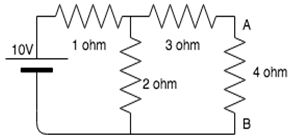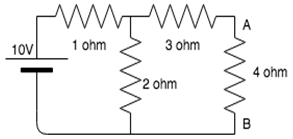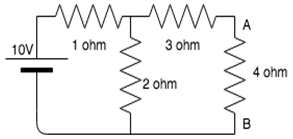1. Calculate the Thevenin resistance across the terminal AB for the following circuit.
a) 4.34 ohm
b) 3.67 ohm
c) 3.43 ohm
d) 2.32 ohm
Explanation: Thevenin resistance is found by opening the circuit between the specified terminal and shorting all voltage sources.
When the 10V source is shorted, we get:
Rth=(1||2)+3=3.67 ohm.
2. Calculate Vth for the given circuit.
a) 5.54V
b) 3.33V
c) 6.67V
d) 3.67V
Explanation: 4 ohm is removed and then v across 2 ohm is calculated by voltage divider 2*10/(2+1) = 6.67V. Voltage between A and B i.e. Vth is equal to voltage across 4 ohm resistance since no current flow through 3 ohm resistance. So, Vth = 6.67V.
3. Calculate the current across the 4 ohm resistor.
a) 0.86A
b) 1.23A
c) 2.22A
d) 0.67A
Explanation: Thevenin resistance is found by opening the circuit between the specified terminal and shorting all voltage sources.
When the 10V source is shorted, we get:
Rth=(1||2)+3=3.67 ohm.
Vth is calculated by opening the specified terminal.
Using voltage divider, Vth= 2*10/(2+1)=6.67V.
On drawing the Thevenin equivalent circuit, we get Rth, 4 ohm and Vth in series.
Applying Ohm’s law, I=Vth/(4+Rth) = 0.86A.
4. The Thevenin voltage is the__________
a) Open circuit voltage
b) Short circuit voltage
c) Open circuit and short circuit voltage
d) Neither open circuit nor short circuit voltage
Explanation: Thevenin voltage is obtained by opening the specified terminals so it is open circuit voltage. It is not the short circuit voltage because if specified terminals are shorted voltage is equal to zero.
5. Thevenin resistance is found by ________
a) Shorting all voltage sources
b) Opening all current sources
c) Shorting all voltage sources and opening all current sources
d) Opening all voltage sources and shorting all current sources
Explanation: Ideal current sources have infinite internal resistance hence behave like an open circuit whereas ideal voltage sources have zero internal resistance hence behave as a short circuit.
6. Thevenin’s theorem is true for __________
a) Linear networks
b) Non-Linear networks
c) Both linear networks and nonlinear networks
d) Neither linear networks nor non-linear networks
Explanation: Thevenin’s theorem works for only linear circuit elements and not non-linear ones such as BJT, semiconductors etc.
7. In Thevenin’s theorem Vth is __________
a) Sum of two voltage sources
b) A single voltage source
c) Infinite voltage sources
d) 0
Explanation: Thevenin’s theorem states that a combination of voltage sources, current sources and resistors is equivalent to a single voltage source V and a single series resistor R.
8. Vth is found across the ____________ terminals of the network.
a) Input
b) Output
c) Neither input nor output
d) Either input or output
Explanation: According to Thevenin’s theorem, Vth is found across the output terminals of a network and not the input terminals.
9. Which of the following is also known as the dual of Thevenin’s theorem?
a) Norton’s theorem
b) Superposition theorem
c) Maximum power transfer theorem
d) Millman’s theorem
Explanation: Norton’s theorem is also known as the dual of Thevenin’s theorem because in Norton’s theorem we find short circuit current which is the dual of open circuit voltage-what we find in Thevenin’s theorem.
10. Can we use Thevenin’s theorem on a circuit containing a BJT?
a) Yes
b) No
c) Depends on the BJT
d) Insufficient data provided
Explanation: We can use Thevenin’s theorem only for linear networks. BJT is a non-linear network hence we cannot apply Thevenin’s theorem for it.